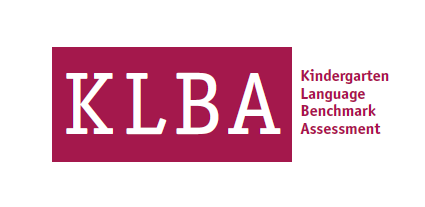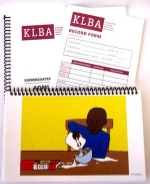 |
| Picture courtesy of: www.sl3lab.com |
The KLBA is a product of Speech Language Literacy Lab, LLC and was created by two speech-language pathologists.
Ages: 5-6 years
Administration time: Within 5 minutes (depending on your familiarity of the test protocol and how quickly you can transcribe responses)
Population: KLBA was created to be used on both monolingual and bilingual speakers with the expressed purpose to reduce over-identification of ELL (English language learners) by "reducing expressive grammar requirements" according to the manual.
 |
| Picture courtesy of www.sl3lab.com |
What areas does this assessment target?
- Auditory Comprehension: answering simple questions after hearing a short story accompanied with a picture.
- Following Directions: following simple and multi-step directions.
- Categories Receptive: identifying which two items (from a field of three) belong to the same category.
- Categories Expressive: naming the category to which the items belong.
- Narrative Language: telling a simple narrative given various prompts.
How does this assessment work?
After giving each prompt to the students you determine the raw score (RS) by adding up the number of correct responses for each subtest and place the RS in the designated spot on the score table. Then total the RS for all subtests.
Once all students in the class have been assessed, order all scores from highest to lowest. Separate the scores by quarters and provide Tier 2 RtI services to those students that fall in the bottom 15-25% of the class.
Assess in the Fall, Winter and Spring (3x/year) and move children in and out of the respected Tier 2 intervention services based on their improvement or lack their of upon reassessment.
What I like about this assessment:
- It is quick and easy to administer.
- It is language based and a quick, concise way to determine which students should be followed and which students require RtI services at which designated tier.
- The assessment can be given three times a year to monitor and demonstrate progress.
- You can move students in and out of RtI services based on a student's progress or lack there of.
- This assessment is looking for content not correct grammatical forms, which are often incorrectly produced not only by children with language disorders/delays but also by children who are truly ELL.
- Students' scores are compared to each other within each classroom therefore allowing for differences in performance among various classrooms. It could become obvious that one particular classroom is in more need of services based on the number of students who fall below 25% performance and could result in some more classroom based or push-in RtI services.
- This could also aid in streamlining an SLP's RtI caseload and responsibilities depending on how the SLP is used within the RtI process.
- I would like to see how this particular measure identifies the at-risk population over time.
- I would also like to see how SLPs and regular educators are working together to use this measure to streamline their RtI identification process for this young student population.
I can see this particular measure being used in a number of ways including:
- When SLPs are transitioning their PK students to K, they can provide the incoming teacher and new SLP with the student's current KLBA performance prior to the beginning of the school year, regardless of whether they will remain on the speech therapy caseload for the K year.
- For schools who do have some type of K screening process prior to beginning the school year, using the KLBA at that time would be a perfect time to determine who would begin with RtI services as soon as the school year commences.
- SLPs could use the KLBA as part of their initial screenings as well or for whole classroom screenings as some school districts require their SLPs to do. This could be an invaluable time saver!
- I can even see the KLBA being used by a private practitioner as part of a quick and dirty community screening. Any young children struggling on the KLBA can be referred for further testing as needed. In addition, this product could be particularly helpful in an area where there are a high number of bilingual speakers.
So there are a number of reasons I like this assessment and a number of ways I can envision the KLBA to be used. If you are interested in purchasing it please go to the KLBA webpage to find out more.


Thanks for the review Maria!
ReplyDelete